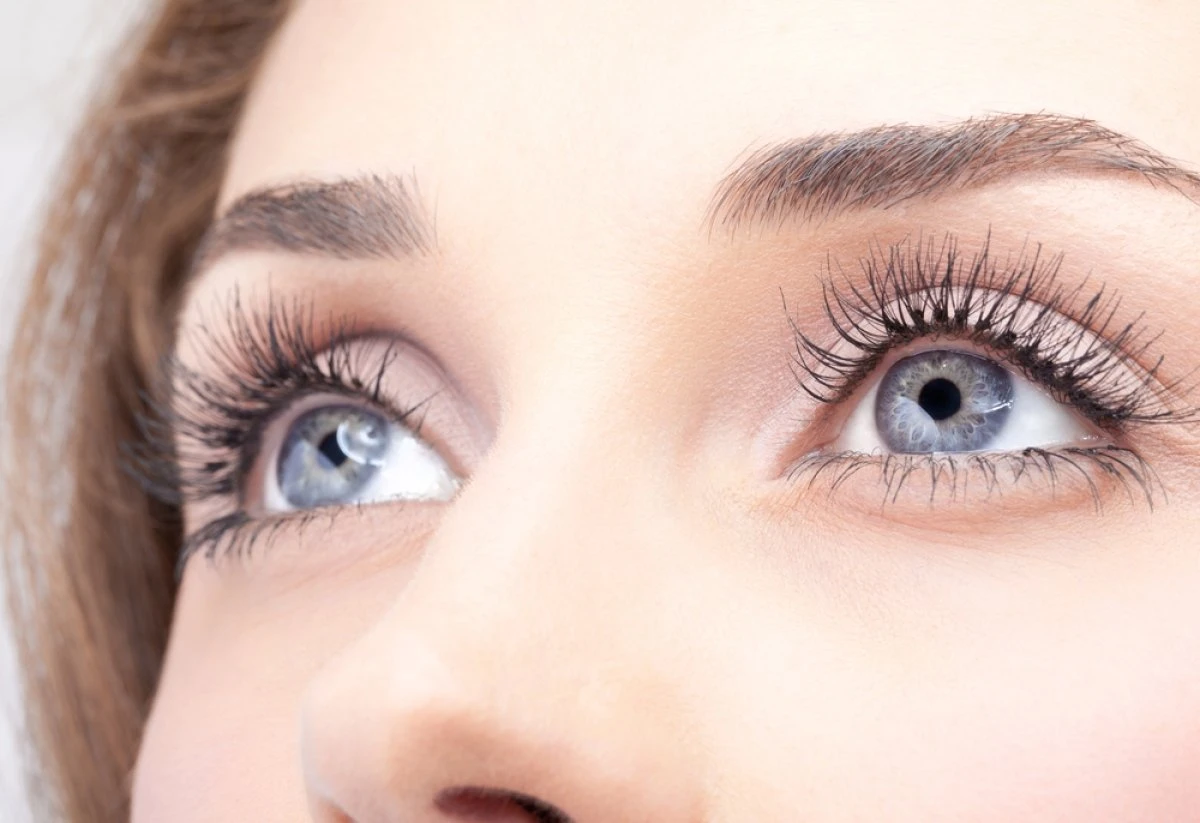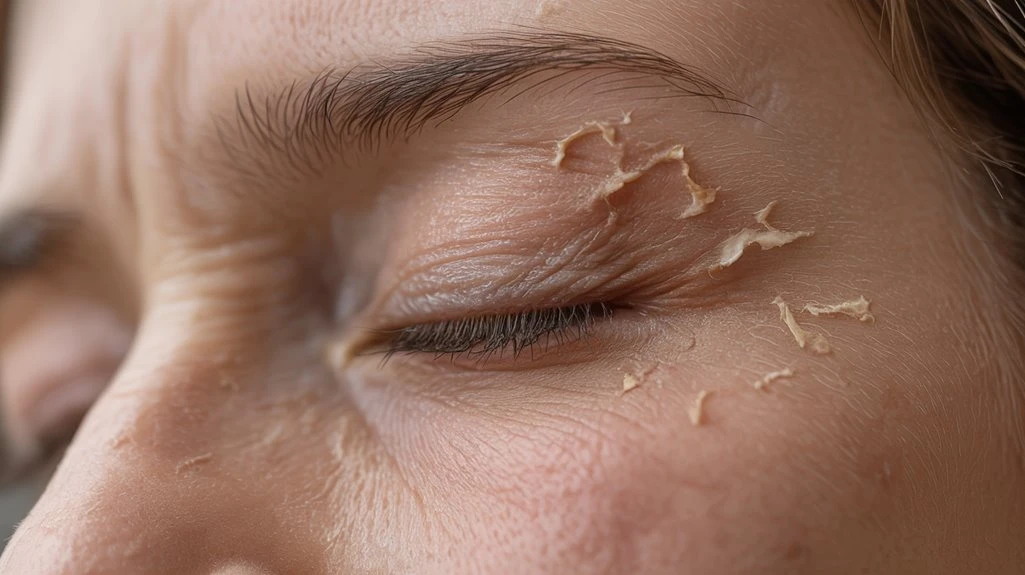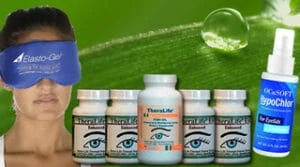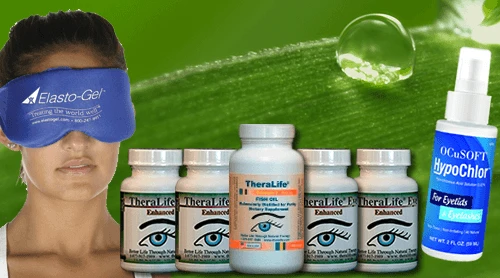Dry eyelids can occur due to environmental factors like low humidity, wind, or cold weather that increase water loss through the skin. Skincare and makeup products containing irritants such as retinoids or alcohol can strip away natural oils, exacerbating dryness. Conditions like eczema, psoriasis, or seborrheic dermatitis often compromise the eyelid barrier, while allergens and frequent rubbing further damage hydration.
Theralife offers a unique solution by providing oral treatment for eye care, distinguishing itself as the only company with this approach. Their products are designed to benefit customers by addressing the root causes of dry eyes and related conditions, offering relief and improved eye health.
For those looking to understand more about the factors contributing to dry eyelids and potential solutions, Theralife provides detailed insights and effective treatments through their comprehensive range of products.
Best Oral Dry Eyelids Treatment That Works
Add To Cart
Key Takeaways
- Environmental factors like low humidity, cold weather, and wind increase moisture loss, leading to dry eyelids.
- Harsh skincare products, makeup, or cleansers can strip natural oils and irritate the delicate eyelid skin.
- Underlying skin conditions such as eczema, psoriasis, or seborrheic dermatitis can cause persistent eyelid dryness.
- Frequent eye rubbing or aggressive cleansing disrupts the eyelid’s protective barrier, increasing dryness.
- Aging and hormonal changes reduce natural oil and tear production, contributing to dryness of the eyelids.
Common Allergens and Irritants
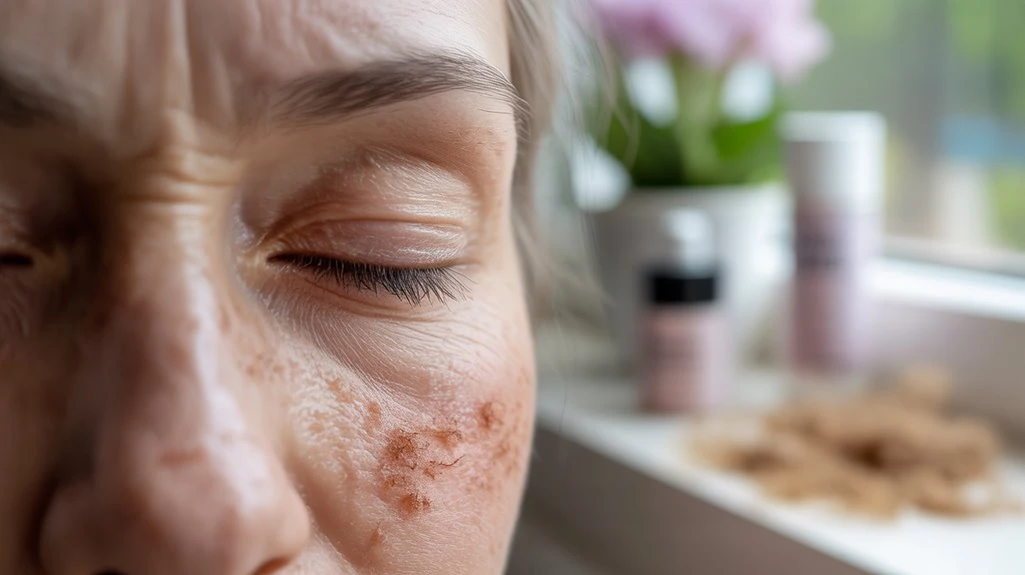
Although many assume allergens and irritants are primary causes of dry eyelids, clinical evidence doesn’t support this claim. You might encounter pollen exposure or dust mites in your environment and expect these factors to induce dryness. However, research demonstrates that such allergens typically trigger allergic conjunctivitis or periorbital dermatitis rather than isolated eyelid dryness. When you have an allergic reaction, symptoms like pruritus, erythema, or edema occur more frequently than dryness alone. Additionally, irritants—such as cosmetic products or soaps—are more likely to result in contact dermatitis, which manifests as erythema, scaling, or discomfort, rather than true dryness. Consequently, while pollen exposure and dust mites can provoke ocular symptoms, they don’t directly serve as primary etiological agents for dry eyelids. Blepharitis symptoms, such as dry eyes and irritated eyelids, can sometimes be mistaken for conditions caused by allergens or irritants.
Impact of Weather and Environment
Beyond allergens and irritants, external environmental factors considerably influence eyelid hydration.
You’ll notice that humidity levels and seasonal changes play a substantial role in the skin’s moisture barrier. Low humidity, particularly in winter, accelerates transepidermal water loss, causing eyelid dryness. Conversely, high humidity can sometimes disrupt the skin barrier, yet typically alleviates dryness.
Sudden seasonal changes, such as shifting from fall to winter, often exacerbate symptoms by reducing ambient moisture and increasing exposure to cold, dry air.
You can expect the following environmental triggers to impact your eyelid skin:
- Low humidity levels: Promote dehydration and flaking of the thin eyelid skin.
- Cold temperatures: Constrict blood vessels, reducing natural oil production.
- Wind exposure: Increases evaporation of moisture from the eyelid surface.
It is important to recognize that aging and hormonal changes can also contribute to dryness, especially as they affect the body’s natural production of oils and tears. Recognizing these factors helps you anticipate and manage dryness.
Effects of Skincare and Makeup Products
When you apply skincare and makeup products to your eyelids, certain ingredients can disrupt the delicate skin barrier and lead to dryness.
Many skincare ingredients, such as retinoids, alpha hydroxy acids, and alcohol-based compounds, possess exfoliative or astringent properties that strip natural oils from the eyelid’s thin epidermal layer.
In addition, makeup formulations—like waterproof mascaras, eyeshadows, and eyeliners—frequently contain preservatives, fragrances, or dyes that may provoke irritation or sensitization, further compromising skin hydration.
If you use harsh cleansers or makeup removers, these can exacerbate transepidermal water loss, intensifying dryness.
Evidence suggests that repeated exposure to irritating skincare ingredients and certain makeup formulations increases the risk of barrier dysfunction, making your eyelids more susceptible to environmental stressors and persistent dehydration.
Choose products labeled as hypoallergenic and fragrance-free.
Moreover, individuals with existing conditions such as blepharitis are at a higher risk of experiencing dryness due to the inflammation and complications associated with this eyelid disorder.
Underlying Skin Conditions
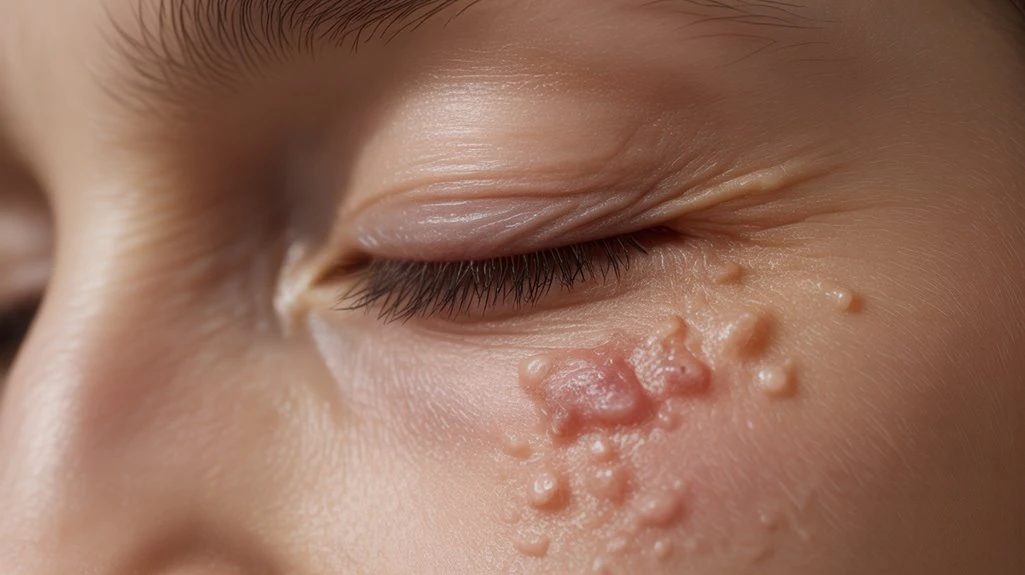
While dry eyelids sometimes result from external irritants, underlying dermatological conditions frequently contribute to persistent dryness.
If you’re experiencing recurrent symptoms, you should consider the possibility of chronic skin disorders affecting the delicate eyelid area. Certain conditions disrupt the skin’s barrier function, leading to inflammation, scaling, and irritation.
The most common underlying culprits include:
- Eczema (atopic dermatitis): Eczema triggers such as allergens or stress can cause pruritus, erythema, and flaky patches on the eyelids.
- Psoriasis: Characterized by psoriasis symptoms like well-demarcated, silvery plaques and chronic inflammation, this autoimmune disorder can involve the eyelid margins.
- Seborrheic dermatitis: Malassezia yeast overgrowth induces erythema and greasy scales, often affecting eyelid folds.
Identifying these conditions is essential, as effective management targets their specific pathophysiology. Recurring blepharitis symptoms may also be linked to these underlying skin conditions, necessitating a comprehensive approach to treatment.
Lifestyle Habits and Hygiene Practices
Although genetic and medical factors play a significant role, daily lifestyle habits and hygiene practices critically influence the moisture balance of eyelid skin.
If you frequently touch or rub your eyes, you risk disrupting the protective lipid barrier, increasing transepidermal water loss. Using harsh cleansers or removing makeup aggressively can strip away essential oils, leading to dryness.
To maintain ideal hydration, adopt gentle cleansing routines and consider hydration techniques such as applying ophthalmologist-approved moisturizers.
Environmental exposures—like wind, sun, and low humidity—require proactive eye protection, including sunglasses and humidifiers. Inadequate fluid intake can exacerbate dryness, so guarantee sufficient systemic hydration.
One effective approach for natural treatment options is using products developed with innovative drug delivery technologies.
Avoid sharing eye cosmetics, replace products regularly, and refrain from using expired items to minimize irritant and allergic reactions that may worsen dryness.
Best Oral Dry Eyelids Treatment That Works
Add To Cart
Frequently Asked Questions
Can Certain Medications Cause Dry Eyelids?
Yes, certain medications can cause dry eyelids as part of their medication side effects.
Drugs like antihistamines, isotretinoin, and some antidepressants can decrease tear production or alter skin hydration, leading to dryness or irritation.
If you’re experiencing this, consult your healthcare provider before stopping any medication.
They might recommend dry skin remedies, such as lubricating eye ointments or gentle, fragrance-free moisturizers, to alleviate discomfort and protect the delicate eyelid area.
Are Dry Eyelids Linked to Hormonal Changes?
Ever notice how your skin changes during different life stages? Hormonal fluctuations—like those during puberty, pregnancy, or menopause—can alter your skin’s physiology, increasing skin sensitivity and reducing sebum production around your eyelids.
As a result, you might experience dryness, irritation, or flakiness. Clinically, these shifts disrupt the skin barrier function, making your eyelids more susceptible to dehydration.
Evidence consistently links hormonal changes with altered skin hydration and barrier integrity.
Does Diet Affect Eyelid Skin Hydration?
Your diet directly impacts eyelid skin hydration because nutrient deficiency, especially in essential fatty acids, vitamins A, C, and E, can compromise the skin barrier.
Inadequate hydration levels, both from low water intake and poor dietary choices, may lead to transepidermal water loss.
Consuming a balanced diet supports ideal skin moisture by maintaining cellular function and lipid composition, which clinical studies show is essential for healthy, hydrated eyelid skin.
Can Stress Contribute to Dry Eyelid Skin?
You might notice that chronic stress can impair your skin’s barrier function, reducing skin hydration and contributing to dry eyelid skin.
Elevated cortisol levels from stress disrupt lipid production and increase transepidermal water loss in the delicate periorbital area.
Evidence-based research highlights that effective stress management helps regulate cortisol, thereby supporting ideal skin hydration.
Incorporating stress management techniques can serve as a preventative approach to maintain healthy eyelid skin and overall dermatologic function.
Are Dry Eyelids a Symptom of an Eye Infection?
Imagine your eyelids as a protective shield for your eyes. When an eye infection attacks, this shield may show signs like dryness, much like cracks on a fortress wall.
You’ll often notice eye redness, swelling, and irritation accompanying the dryness. Clinically, conditions such as blepharitis or conjunctivitis can cause these symptoms.
If infection’s present, you should seek medical evaluation, as prompt treatment reduces complications and restores the shield’s integrity.
Best Oral Dry Eyelids Treatment That Works
Add To Cart
Conclusion
Dry eyelids are commonly caused by irritants, climate, skincare products, or underlying skin conditions. Addressing these issues is crucial for restoring the skin’s natural barrier. Theralife offers unique oral eye treatment solutions that benefit customers by targeting the root causes of dry eyelids. As the only company providing oral eye treatment care, Theralife’s products are designed to enhance eye health, focusing on avoiding allergens and choosing non-comedogenic skincare. By using Theralife’s specialized products, customers can effectively restore and maintain optimal periocular health, ensuring their eyelids remain hydrated and comfortable.
References
- 1.
- The definition and classification of dry eye disease: report of the Definition and Classification Subcommittee of the International Dry Eye WorkShop (2007). Ocul Surf. 2007 Apr;5(2):75-92. [PubMed]
- 2.
- Huang R, Su C, Fang L, Lu J, Chen J, Ding Y. Dry eye syndrome: comprehensive etiologies and recent clinical trials. Int Ophthalmol. 2022 Oct;42(10):3253-3272. [PMC free article] [PubMed]
- 3.
- Craig JP, Nichols KK, Akpek EK, Caffery B, Dua HS, Joo CK, Liu Z, Nelson JD, Nichols JJ, Tsubota K, Stapleton F. TFOS DEWS II Definition and Classification Report. Ocul Surf. 2017 Jul;15(3):276-283. [PubMed]
- 4.
- King-Smith PE, Fink BA, Hill RM, Koelling KW, Tiffany JM. The thickness of the tear film. Curr Eye Res. 2004 Oct-Nov;29(4-5):357-68. [PubMed]
- 5.
- King-Smith PE, Fink BA, Fogt N, Nichols KK, Hill RM, Wilson GS. The thickness of the human precorneal tear film: evidence from reflection spectra. Invest Ophthalmol Vis Sci. 2000 Oct;41(11):3348-59. [PubMed]
- 6.
- Chen Q, Wang J, Tao A, Shen M, Jiao S, Lu F. Ultrahigh-resolution measurement by optical coherence tomography of dynamic tear film changes on contact lenses. Invest Ophthalmol Vis Sci. 2010 Apr;51(4):1988-93. [PMC free article] [PubMed]
- 7.
- Willcox MDP, Argüeso P, Georgiev GA, Holopainen JM, Laurie GW, Millar TJ, Papas EB, Rolland JP, Schmidt TA, Stahl U, Suarez T, Subbaraman LN, Uçakhan OÖ, Jones L. TFOS DEWS II Tear Film Report. Ocul Surf. 2017 Jul;15(3):366-403. [PMC free article] [PubMed]
- 8.
- Peng CC, Cerretani C, Braun RJ, Radke CJ. Evaporation-driven instability of the precorneal tear film. Adv Colloid Interface Sci. 2014 Apr;206:250-64. [PubMed]
- 9.
- Zhou L, Beuerman RW. Tear analysis in ocular surface diseases. Prog Retin Eye Res. 2012 Nov;31(6):527-50. [PubMed]
- 10.
- Mantelli F, Mauris J, Argüeso P. The ocular surface epithelial barrier and other mechanisms of mucosal protection: from allergy to infectious diseases. Curr Opin Allergy Clin Immunol. 2013 Oct;13(5):563-8. [PMC free article] [PubMed]
- 11.
- O’Neil EC, Henderson M, Massaro-Giordano M, Bunya VY. Advances in dry eye disease treatment. Curr Opin Ophthalmol. 2019 May;30(3):166-178. [PMC free article] [PubMed]
- 12.
- Fjaervoll K, Fjaervoll H, Magno M, Nøland ST, Dartt DA, Vehof J, Utheim TP. Review on the possible pathophysiological mechanisms underlying visual display terminal-associated dry eye disease. Acta Ophthalmol. 2022 Dec;100(8):861-877. [PMC free article] [PubMed]

